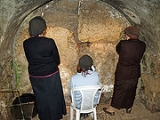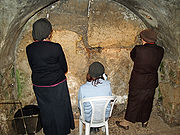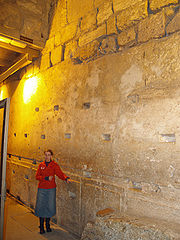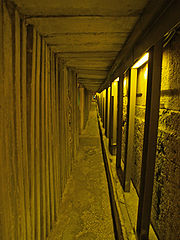
Western Wall Tunnel
Encyclopedia


Transliteration
Transliteration is a subset of the science of hermeneutics. It is a form of translation, and is the practice of converting a text from one script into another...
: Minheret Hakotel) is an underground tunnel exposing the full length of the Western Wall
Western Wall
The Western Wall, Wailing Wall or Kotel is located in the Old City of Jerusalem at the foot of the western side of the Temple Mount...
. The tunnel is adjacent to the Western Wall and is located under buildings of the Old City of Jerusalem, Israel
Israel
The State of Israel is a parliamentary republic located in the Middle East, along the eastern shore of the Mediterranean Sea...
. While the open-air portion of the Western Wall is approximately 60 metres (196.9 ft) long, the majority of its original length is hidden underground. The tunnel allows access to an additional 485 metres (1,591.2 ft) of the wall.
History
In 19 BCE, King Herod undertook a project to double the area of the Temple Mount in Jerusalem by incorporating part of the hill on the Northwest. In order to do so, four retaining walls were constructed, and the Temple Mount was expanded on top of them. These retaining walls remained standing, along with the platform itself, after the Temple was destroyed by the Romans in 70 CE.However, since then much of the area next to the walls became covered and built upon.
Part of the Western Wall remained exposed after the destruction of the Temple. Since it was the closest area to the Temple’s Holy of Holies that remained accessible, it became a place of Jewish prayer for millennia.
Excavation

Charles Warren
General Sir Charles Warren, GCMG, KCB, FRS was an officer in the British Royal Engineers. He was one of the earliest European archaeologists of Biblical Holy Land, and particularly of Temple Mount...
in 1867-70. Wilson discovered an arch now named for him, "Wilson's Arch
Wilson's Arch (Jerusalem)
Wilson's Arch is the modern name for the ancient stone arch whose top is still visible today, where it is supported against the Northeast corner of Jerusalem's Western Wall, so that it appears on the left to visitors facing the Wall...
" which was 12.8 metres (42 ft) wide and is above present-day ground level. It is believed that the arch supported a bridge which connected the Temple Mount to the city during the Second Temple Period
Second Temple period
The Second Temple period , in Jewish history, is the period between 530 BCE and 70 CE, when the Second Temple of Jerusalem existed. It ended with the First Jewish–Roman War and the Temple's destruction....
. Warren dug shafts through Wilson’s Arch which are still visible today.
After the Six Day War, the Ministry of Religious Affairs of Israel began the excavations aimed at exposing the continuation of the Western Wall. The excavations lasted almost twenty years and revealed many previously unknown facts about the history and geography of the Temple Mount
Temple Mount
The Temple Mount, known in Hebrew as , and in Arabic as the Haram Ash-Sharif , is one of the most important religious sites in the Old City of Jerusalem. It has been used as a religious site for thousands of years...
. The excavations were difficult to conduct, as the tunnels ran below residential neighborhoods constructed on top of ancient structures from the Second Temple Period
Second Temple period
The Second Temple period , in Jewish history, is the period between 530 BCE and 70 CE, when the Second Temple of Jerusalem existed. It ended with the First Jewish–Roman War and the Temple's destruction....
. The excavations were conducted with the supervision of scientific and rabbinic experts. This was to ensure both the stability of the structures above and to prevent damaging the historic artifacts. In 1988 the Western Wall Heritage Foundation was formed, it took over the excavation, maintenance and renovations of the Western Wall and Western Wall Plaza.
Features
The tunnel exposes a total length of 485 m of the wall, revealing the methods of construction and the various activities in the vicinity of the Temple Mount. The excavations included many archaeological finds along the way, including discoveries from the HerodianHerod the Great
Herod , also known as Herod the Great , was a Roman client king of Judea. His epithet of "the Great" is widely disputed as he is described as "a madman who murdered his own family and a great many rabbis." He is also known for his colossal building projects in Jerusalem and elsewhere, including his...
period (streets, monumental masonry), sections of a reconstruction of the Western Wall dating to the Umayyad
Umayyad
The Umayyad Caliphate was the second of the four major Arab caliphates established after the death of Muhammad. It was ruled by the Umayyad dynasty, whose name derives from Umayya ibn Abd Shams, the great-grandfather of the first Umayyad caliph. Although the Umayyad family originally came from the...
period, and various structures dating to the Ayyubid, Mamluke and Hasmonean
Hasmonean
The Hasmonean dynasty , was the ruling dynasty of Judea and surrounding regions during classical antiquity. Between c. 140 and c. 116 BCE, the dynasty ruled semi-autonomously from the Seleucids in the region of Judea...
periods constructed to support buildings in the vicinity of the Temple Mount.
"Warren's Gate
Warren's Gate
Warren's Gate is an ancient entrance into the Temple platform in Jerusalem which lies about into the Western Wall Tunnel. In the Second Temple period, the gate led to a tunnel and staircase onto the Temple Mount....
" lies about 150 feet (45.7 m) into the tunnel. This sealed-off entrance has been turned into a small synagogue called "The Cave", by Rabbi Yehuda Getz, since it is the closest point a Jew can get to the Holy of Holies
Holy of Holies
The Holy of Holies is a term in the Hebrew Bible which refers to the inner sanctuary of the Tabernacle and later the Temple in Jerusalem where the Ark of the Covenant was kept during the First Temple, which could be entered only by the High Priest on Yom Kippur...
, assuming it was located at the traditional site under the Dome of the Rock
Dome of the Rock
The Dome of the Rock is a shrine located on the Temple Mount in the Old City of Jerusalem. The structure has been refurbished many times since its initial completion in 691 CE at the order of Umayyad Caliph Abd al-Malik...
.
At the northern portion of the Western Wall, remains of a water channel
Water channel
Main article: Ship model basinA water channel is an experimental tank for studying resistance and propulsion behaviour of ships, submarines, or other sea vessels. In the study of naval architecture , its general purpose is to allow understanding of the motion behavior of ships in advance....
, which originally supplied water to the Temple Mount, were found. The exact source of the channel is unknown, though it passes through an underground pool known as the "Struthion Pool
Struthion Pool
The Struthion Pool is a large cuboid cistern beneath the Convent of the Sisters of Zion in the Old City of Jerusalem, built in 1st century BCE and perhaps even earlier.- Construction :...
". The water channel was dated to the Hasmonean
Hasmonean
The Hasmonean dynasty , was the ruling dynasty of Judea and surrounding regions during classical antiquity. Between c. 140 and c. 116 BCE, the dynasty ruled semi-autonomously from the Seleucids in the region of Judea...
period and was accordingly dubbed the "Hasmonean Channel".
The biggest stone in the Western Wall often called the Western Stone
Western Stone
The Western Stone, located in the northern section of Wilson's Arch, is a monolithic stone block forming part of the lower level of the Western Wall in Jerusalem. Weighing 517 tonnes , it is one of the largest building blocks in the world. The stone is 13.6 meters long and 3 metres high and has...
is also revealed within the tunnel and ranks as one of the heaviest objects ever lifted by human beings without powered machinery. The stone has a length of 13.6 metres (44.6 ft) and an estimated width of between 3.5 metres (11.5 ft) and 4.5 metres (14.8 ft); estimates place its weight at 570 short ton.
Adjacent to the tunnel lies a museum called "The Chain of Generations Center," designed by Eliav Nahlieli. The Center, which incorporates ancient and modern Jewish history, includes an audiovisual show, and nine glass sculptures created by glass artist Jeremy Langford
Jeremy Langford
Jeremy Langford , British/Israeli glass designer and sculptor known for his monumental stacked glass sculptures. His family's original name was Lelyveld, natives of the Netherlands, and Langford is related to Joseph Lelyveld, an editor of The New York Times, and to civil rights activist Rabbi...
.
In 2007 the Israel Antiquities Authority
Israel Antiquities Authority
The Israel Antiquities Authority is an independent Israeli governmental authority responsible for enforcing the 1978 Law of Antiquities. The IAA regulates excavation and conservation, and promotes research...
uncovered an ancient Roman street, thought to be from the second to fourth centuries. It was a side street which likely connected two major roads, and led up to the Temple Mount. The discovery of the road gave further evidence that Romans continued to use the Temple Mount after the destruction of the temple in 70 CE.
Struthion Pool
The Struthion Pool is a large cuboid cistern, which gathered the rainRain
Rain is liquid precipitation, as opposed to non-liquid kinds of precipitation such as snow, hail and sleet. Rain requires the presence of a thick layer of the atmosphere to have temperatures above the melting point of water near and above the Earth's surface...
water from guttering
Rain gutter
A rain gutter is a narrow channel, or trough, forming the component of a roof system which collects and diverts rainwater shed by the roof....
on the Forum buildings. Prior to Hadrian, this cistern had been an open-air pool, but Hadrian added arch vaulting to enable the pavement to be placed over it. The existence of the pool in the first century is attested by Josephus
Josephus
Titus Flavius Josephus , also called Joseph ben Matityahu , was a 1st-century Romano-Jewish historian and hagiographer of priestly and royal ancestry who recorded Jewish history, with special emphasis on the 1st century AD and the First Jewish–Roman War, which resulted in the Destruction of...
, who reports that it was called Struthius (literally meaning sparrow). This Struthion Pool was originally built as part of an open-air water conduit
Waterway
A waterway is any navigable body of water. Waterways can include rivers, lakes, seas, oceans, and canals. In order for a waterway to be navigable, it must meet several criteria:...
by the Hasmonean
Hasmonean
The Hasmonean dynasty , was the ruling dynasty of Judea and surrounding regions during classical antiquity. Between c. 140 and c. 116 BCE, the dynasty ruled semi-autonomously from the Seleucids in the region of Judea...
s, which has since been enclosed; the source of the water for this conduit is currently unidentified.
As a result of 1971 extensions to the original Western Wall Tunnel, the Hasmonean water system became linked to the end of the Western Wall Tunnel; although they run under Arab
Arab
Arab people, also known as Arabs , are a panethnicity primarily living in the Arab world, which is located in Western Asia and North Africa. They are identified as such on one or more of genealogical, linguistic, or cultural grounds, with tribal affiliations, and intra-tribal relationships playing...
housing, and later opened as a tourist attraction. The attraction has a linear route, starting at the Western Wall Plaza, passing through the modern tunnels, then the ancient water system, and ending at the Struthion Pool; as the Sisters of Zion were not willing to allow tourists to exit into the Convent of the Sisters of Zion
Convent of the Sisters of Zion
The Convent of the Sisters of Zion is a convent of the Congregation of Notre-Dame de Sion, located near to the eastern end of the Via Dolorosa, in Jerusalem. The convent was built in 1857, by Marie-Alphonse Ratisbonne, but the site also contains ancient archaeological remains of significant value.-...
via the Struthion Pool, tourists had to return through the narrow tunnels to their starting point, creating logistical
Logistics
Logistics is the management of the flow of goods between the point of origin and the point of destination in order to meet the requirements of customers or corporations. Logistics involves the integration of information, transportation, inventory, warehousing, material handling, and packaging, and...
issues.
Northern exit and riots
Originally, tourists in the tunnel had to retrace their steps back to the entrance. A connection to the Hasmonean water system was made, but this still required tourists to eventually make a U-turn once they had reached the Struthion Pool.Digging an alternative exit from the tunnel was proposed, but initially rejected on the grounds that any exit would be seen as an attempt by the Jewish authorities to stake a claim to ownership of the nearby land — part of the Muslim Quarter of the city; in 1996, however, Benjamin Netanyahu
Benjamin Netanyahu
Benjamin "Bibi" Netanyahu is the current Prime Minister of Israel. He serves also as the Chairman of the Likud Party, as a Knesset member, as the Health Minister of Israel, as the Pensioner Affairs Minister of Israel and as the Economic Strategy Minister of Israel.Netanyahu is the first and, to...
authorized the creation of an exit leading to the Via Dolorosa
Via Dolorosa
The Via Dolorosa is a street, in two parts, within the Old City of Jerusalem, held to be the path that Jesus walked, carrying his cross, on the way to his crucifixion. The current route has been established since the 18th century, replacing various earlier versions...
, underneath the Ummariya madrasah
Umariya Elementary School
The Umariya Elementary School is a prestigious madrassa in the Muslim Quarter of Jerusalem's Old City. It is located at the start of the Via Dolorosa, and is adjacent to the Convent of the Sisters of Zion...
. Over the subsequent few weeks, 80 people were killed as a result of riots against the creation of the exit. A modern wall divides the Struthion pool into two parts, preventing access between them; one side is visible from the western wall tunnels, the other is area accessible from the Convent of the Sisters of Zion. Since then, it has been possible for large numbers of tourists to enter the tunnel's southern entrance near the Western Wall
Western Wall
The Western Wall, Wailing Wall or Kotel is located in the Old City of Jerusalem at the foot of the western side of the Temple Mount...
, walk the tunnel's length with a tour guide, and exit from the northern end.
See also
- Excavations at the Temple MountExcavations at the Temple MountSeveral excavations at the Temple Mount have taken place. The first archaeological excavations at the site was by the British Royal Engineers in the 1870s....
- The Western WallWestern WallThe Western Wall, Wailing Wall or Kotel is located in the Old City of Jerusalem at the foot of the western side of the Temple Mount...
- Western StoneWestern StoneThe Western Stone, located in the northern section of Wilson's Arch, is a monolithic stone block forming part of the lower level of the Western Wall in Jerusalem. Weighing 517 tonnes , it is one of the largest building blocks in the world. The stone is 13.6 meters long and 3 metres high and has...
- Wilson's ArchWilson's Arch (Jerusalem)Wilson's Arch is the modern name for the ancient stone arch whose top is still visible today, where it is supported against the Northeast corner of Jerusalem's Western Wall, so that it appears on the left to visitors facing the Wall...
External links
- Jerusalem Guide to the Western wall tunnels
- Ministry of Religious Affairs. Hebrew descriptions + photos of sites within the tunnel
- Information from the Kotel site in English
- Jeremy Langford's glass sculptures in "The Chain of Generations Center" in the Western Wall Tunnels
- Read the iTour Jerusalem review of the Western Wall Tunnel

